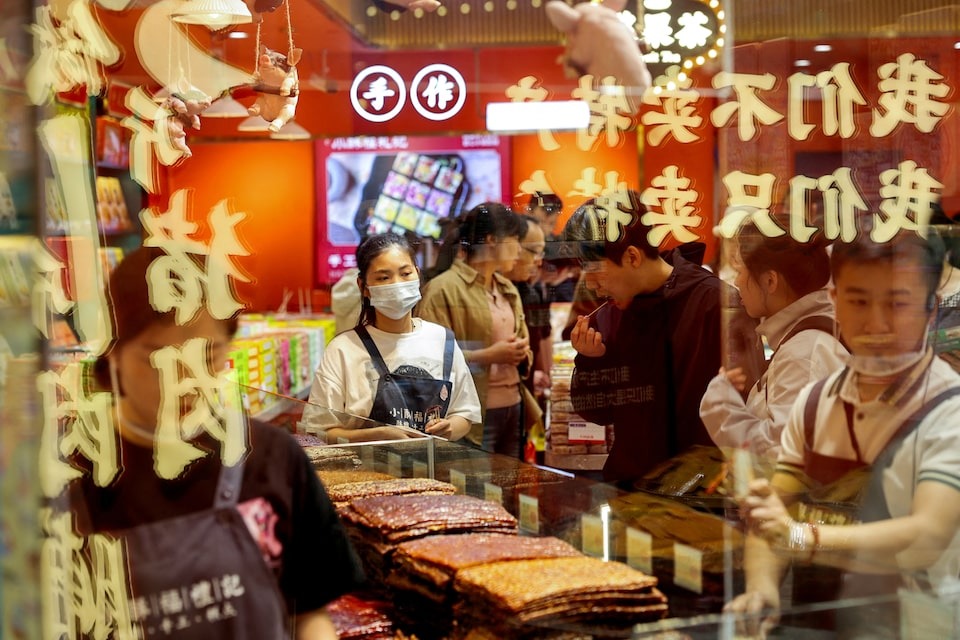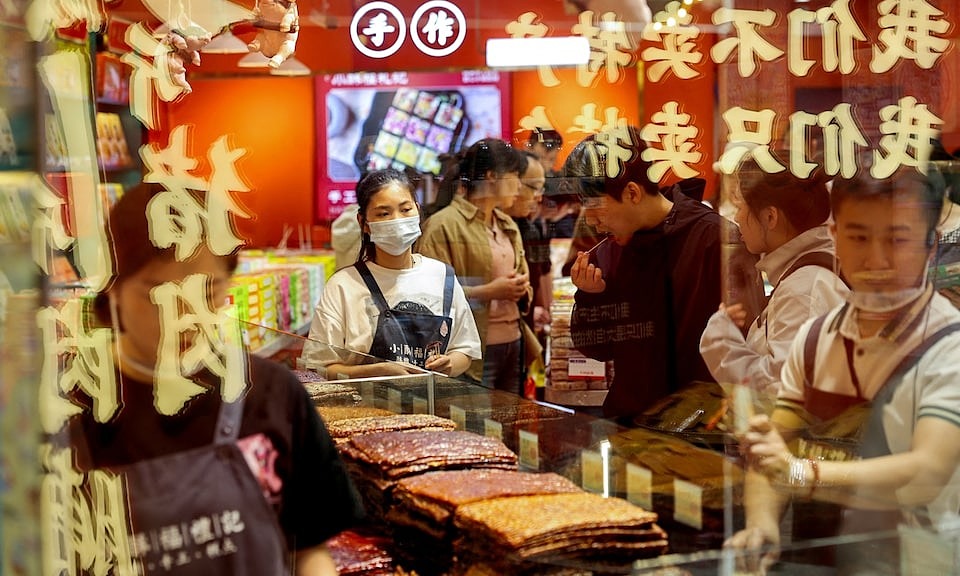During the May Day holiday, Chinese travelers increased their expenditures by 8% compared to the previous year, reaching 180.27 billion yuan (approximately US$24.92 billion). However, this figure remained below pre-pandemic levels. Additionally, China’s service sector experienced growth at its lowest rate in seven months throughout April.
The May Day holiday, one of the country’s longest, is closely watched as a barometer of Chinese consumer confidence.

|
|
Shoppers browse through a souvenir store over the five-day Labour Day holiday in Shanghai, China on May 4, 2025. Image captured by Reuters. |
People shop at a souvenir store during the five-day Labour Day holiday in Shanghai, China May 4, 2025.
Over the course of the five-day holiday, 10.9 million individuals traveled into and out of the country, marking a rise of 28.7% from 2024 figures. Among these, 1.1 million were foreign visitors, representing a significant surge of 43.1%, as reported officially.
Xinhua
news agency said.
However, during the five-day May holiday period, which usually sees high levels of family travel, overall expenditure per person increased only slightly by 1.5%, reaching 574.1 yuan (US$79).
Reuters
analyses derived from authorized statistics indicated.
It still stays under the 2019 level where per capita expenditure was 603.4 yuan.
In the world’s second-biggest economy, consumption has been hit hard due to sluggish growth and an extended real estate downturn. Additionally, the repercussions of the U.S.-China trade dispute are expected to exacerbate these difficulties further.
During the holiday period, China’s tourism authority reported 314 million domestic travels, marking a rise of 6.5%. Additionally, transactions via WeChat Pay, a widely used payment application, surged over 10% compared to the previous year, particularly showing growth in dining expenditures.
Cinemas suffered a significant drop in ticket sales, with the box office haul over the five-day holiday at 747 million yuan, only about half of the same period in 2024.
Growth slackening
Meanwhile, China’s services sector saw new order growth slacken from March, weighed by uncertainty caused by U.S. tariffs, a private sector survey showed on Tuesday.
Despite stronger-than-expected economic growth in the first quarter, supported by government stimulus, China’s economy continues to face persistent deflationary risks.
The Caixin/S&P Global services purchasing managers’ index (PMI), fell to 50.7 from 51.9 in March, its lowest reading since September. The 50-mark separates expansion from contraction.
This generally matched China’s official survey, indicating that services sector activity eased slightly to 50.1 from 50.3 in the prior month. The Caixin PMI is seen as a more accurate indicator for trends among export-focused and smaller companies.
The Caixin services survey indicated that the expansion of new business decelerated to its lowest point since December 2022; however, export orders saw a minor increase, largely attributed to a rebound in tourism.
The decline in the Caixin PMI offers “additional proof that the trade war is negatively impacting economic activities in China, extending beyond just the manufacturing industry,” stated Zichun Huang, who works as an economist for Capital Economics specializing in China.
“Although prudence is necessary, we believe companies might be exaggerating the impact of U.S. tariffs,” she stated.
In 2023, approximately 48% of China’s workforce was employed in the service sector, which accounted for 56.7% of the nation’s GDP. However, U.S. President Donald Trump’s trade policies could significantly impact the manufacturing industry, potentially undermining businesses’ hiring intentions and reducing consumer optimism.
Sentiment within the services industry expanded at its most gradual rate since February 2020, as businesses reported
U.S. tariffs
as a major concern.
For two consecutive months, service companies have reduced their workforce to control expenses, which has resulted in an increase in unfinished tasks. This caused a metric tracking these backlogs to enter expansionary territory for the first time this year.
Companies lowered their prices to draw in customers even as they faced increased expenses for materials.
Lynn Song, the chief economist at ING in Hong Kong, stated that in contrast to governmental aid initiatives aimed at particular goods like appliances via a trade-in program, there hasn’t been much assistance provided yet to encourage higher service sector spending.
To bolster domestic demand, consumption vouchers could be a short term boost, while improving the quality, availability, and range of services over the long term remained key, he said.
“For consumption as a whole, it is important to restore consumer confidence to unlock savings, starting with restoring a positive wealth effect and exiting the contractionary mindset to resume reasonable wage growth.”


Leave a Reply